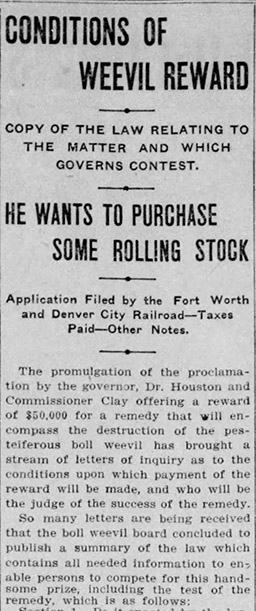
In 2015, Agriculture Commissioner Sid Miller announced that the boll weevil had been completely eradicated in the West Texas Maintenance Area, and that it was functionally eradicated in several other regions. Around a hundred years after the cotton crop pest was first noted to be in Texas, the bugs are finally, mostly, gone...or at least more controlled.
But in the late 1800s and early 1900s, the snout beetle's destructive impact on the Texas cotton industry was looking quite dire. Described in the Handbook of Texas Online as "one of the most devastating pests ever introduced to American agriculture," an estimated 700,000 bales were lost to the boll weevil in 1904, at a cost of $42 million. The blow to Texas' cotton culture kept growing as the insects spread to every cotton production area in Texas. Boll weevils resisted all of the agriculture industry's conventional insecticides and anti-pest practices of the time.
Something had to be done. In 1899, the state appointed Frederick W. Mally as state entomologist and charged him with combating the weevils. His plans were lauded by subsequent entomologists, but heavy rainfall and the Galveston hurricane of 1900, along with inadequate funding, derailed his efforts.
E. Dwight Sanderson was named the next state entomologist in 1901. The state also decided to try a new tactic. With HB 243, 28R, the legislature appropriated a $50,000 prize "to be paid to any one who will discover and furnish a practical remedy that will exterminate the cotton boll weevil, and $2,500.00 for expenses and per diem of committee to pass on the findings of said person or persons." In today's dollars, that prize would be more than $1 million—but still just a fraction of the money that was lost annually to the boll weevil's destruction. Gov. S.W.T. Lanham announced the award 115 years ago this week, on the steps of the Capitol in July 1903.
According to the Handbook of Texas, "the prize offered by the legislature made both themselves and the boll weevil a figure of fun for newspapers throughout the nation, and this episode is sometimes found in civics or government texts as an illustration of the foolishness of lawmaking bodies." Although Texas newspaper articles testify to citizens' interest in the prize, it was never claimed.
Between 1899 and 2013, 32 bills were introduced with "boll weevil" in the caption, illustrating the ongoing battle with the bugs. The current statutes on "Cotton Diseases and Pests" can be found in Chapter 74 of the Agriculture Code. Starting around 1903, boll weevil pest management efforts began to see more promising results on Walter C. Porter's demonstration farm at Terrell, under the leadership of Seaman A. Knapp. Most recently, with the help of the Texas Boll Weevil Eradication Foundation (established by SB 30, 73R), boll weevils are much fewer and farther between in Texas now…without the incentive of cash prizes from the Legislature.
The Austin-American Statesman, Saturday, July 18, 1903 excerpt courtesy of Newspapers.com. Tile image courtesy of the Internet Archive and Flickr Creative Commons, from the 26th Annual Catalogue and Pricelist of Seeds, 1899 (Alexander Seed Company), U.S. Department of Agriculture, National Agriculture Library.

